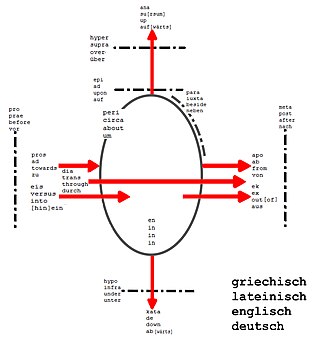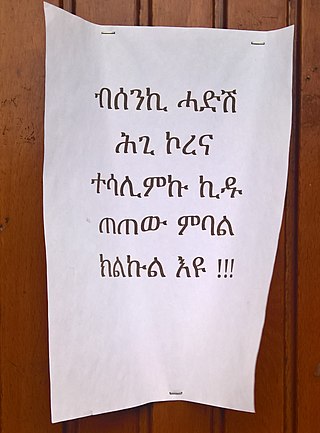Related Research Articles

A prefix is an affix which is placed before the stem of a word. Particularly in the study of languages, a prefix is also called a preformative, because it alters the form of the word to which it is affixed.
In grammar, the comitative case is a grammatical case that denotes accompaniment. In English, the preposition "with", in the sense of "in company with" or "together with", plays a substantially similar role.

Tetum is an Austronesian language spoken on the island of Timor. It is one of the official languages of Timor-Leste and it is also spoken in Belu Regency and in Indonesian West Timor.
Japanese is an agglutinative, synthetic, mora-timed language with simple phonotactics, a pure vowel system, phonemic vowel and consonant length, and a lexically significant pitch-accent. Word order is normally subject–object–verb with particles marking the grammatical function of words, and sentence structure is topic–comment. Its phrases are exclusively head-final and compound sentences are exclusively left-branching. Sentence-final particles are used to add emotional or emphatic impact, or make questions. Nouns have no grammatical number or gender, and there are no articles. Verbs are conjugated, primarily for tense and voice, but not person. Japanese adjectives are also conjugated. Japanese has a complex system of honorifics with verb forms and vocabulary to indicate the relative status of the speaker, the listener, and persons mentioned.

Tigrinya is an Ethio-Semitic language commonly spoken in Eritrea and in northern Ethiopia's Tigray Region by the Tigrinya and Tigrayan peoples. It is also spoken by the global diaspora of these regions.
An infix is an affix inserted inside a word stem. It contrasts with adfix, a rare term for an affix attached to the outside of a stem, such as a prefix or suffix.
The Japanese language has a system of honorific speech, referred to as keigo, parts of speech that show respect. Their use is mandatory in many social situations. Honorifics in Japanese may be used to emphasize social distance or disparity in rank, or to emphasize social intimacy or similarity in rank. Japanese honorific titles, often simply called honorifics, consist of suffixes and prefixes when referring to others in a conversation.
Niuean is a Polynesian language, belonging to the Malayo-Polynesian subgroup of the Austronesian languages. It is most closely related to Tongan and slightly more distantly to other Polynesian languages such as Māori, Samoan, and Hawaiian. Together, Tongan and Niuean form the Tongic subgroup of the Polynesian languages. Niuean also has a number of influences from Samoan and Eastern Polynesian languages.
Okurigana are kana suffixes following kanji stems in Japanese written words. They serve two purposes: to inflect adjectives and verbs, and to force a particular kanji to have a specific meaning and be read a certain way. For example, the plain verb form 見る inflects to past tense 見た, where 見 is the kanji stem, and る and た are okurigana, written in hiragana script. With very few exceptions, okurigana are only used for kun'yomi, not for on'yomi, as Chinese morphemes do not inflect in Japanese, and their pronunciation is inferred from context, since many are used as parts of compound words (kango).

Alyutor or Alutor is a language of Russia that belongs to the Chukotkan branch of the Chukotko-Kamchatkan languages.
This article deals with Japanese equivalents of English adjectives.
Máku, also spelled Mako, and in the language itself Jukude, is an unclassified language and likely language isolate once spoken on the Brazil–Venezuela border in Roraima along the upper Uraricoera and lower Auari rivers, west of Boa Vista, by the Jukudeitse. 300 years ago, the Jukude territory was between the Padamo and Cunucunuma rivers to the southwest.
Oroha, categorized as an Austronesian language, is one of many languages spoken by Melanesian people in the Solomon Islands. It is also known as Maramasike, Mara Ma-Siki, Oraha, and Oloha, and is used primarily in the southern part of Malaita Island within the Malaita Province. Little Mala is composed of three indigenous languages of the 'Tolo' people which are Na’oni, Pau, and Oroha. They are all slightly different, yet come from the same origin. The three languages may be thought of as different dialects of the same language. The three Tolo villages now harbor schools under the Melanesian Mission.
Apma is the language of central Pentecost island in Vanuatu. Apma is an Oceanic language. Within Vanuatu it sits between North Vanuatu and Central Vanuatu languages, and combines features of both groups.
Yabem, or Jabêm, is an Austronesian language of Papua New Guinea.
This article presents a brief overview of the grammar of the Sesotho and provides links to more detailed articles.

The Nukak language is a language of uncertain classification, perhaps part of the macrofamily Puinave-Maku. It is very closely related to Kakwa.
Mekeo is a language spoken in Papua New Guinea and had 19,000 speakers in 2003. It is an Oceanic language of the Papuan Tip Linkage. The two major villages that the language is spoken in are located in the Central Province of Papua New Guinea. These are named Ongofoina and Inauaisa. The language is also broken up into four dialects: East Mekeo; North West Mekeo; West Mekeo and North Mekeo. The standard dialect is East Mekeo. This main dialect is addressed throughout the article. In addition, there are at least two Mekeo-based pidgins.
Tawala is an Oceanic language of the Milne Bay Province, Papua New Guinea. It is spoken by 20,000 people who live in hamlets and small villages on the East Cape peninsula, on the shores of Milne Bay and on areas of the islands of Sideia and Basilaki. There are approximately 40 main centres of population each speaking the same dialect, although through the process of colonisation some centres have gained more prominence than others.
Malay and Indonesian grammar is the body of rules that describe the structure of expressions in the Malay language and Indonesian. This includes the structure of words, phrases, clauses and sentences. In Malay and Indonesian, there are four basic parts of speech: nouns, verbs, adjectives, and grammatical function words (particles). Nouns and verbs may be basic roots, but frequently they are derived from other words by means of prefixes and suffixes.
References
- ↑ Comrie, Bernard; Haspelmath, Martin; Bickel, Balthasar (2008). "Leipzig glossing rules: Conventions for interlinear morpheme-by-morpheme glosses". Archived from the original on 2019-08-04. Retrieved 2016-04-12.
- ↑ Tadmor, Uri (2005), "Malay-Indonesian and Malayic languages", in Strazny, Philipp (ed.), Encyclopedia of Linguistics, New York: Fitzroy Dearborn, pp. 644–647
- ↑ Colarusso, John (2005), "Georgian and Caucasian languages", in Strazny, Philipp (ed.), Encyclopedia of Linguistics, New York: Fitzroy Dearborn, pp. 380–383
- ↑ Zingler, Tim (15 March 2022). "Circumfixation: A semasiological approach". Word Structure. 15: 55–113. doi:10.3366/word.2022.0199. S2CID 247488121 . Retrieved 29 November 2022.
- ↑ Boeckx, Cedric; Niinuma, Fumikazu (2004), "Conditions on Agreement in Japanese", Natural Language and Linguistic Theory , 22 (3): 453–480, doi:10.1023/B:NALA.0000027669.59667.c5, S2CID 170936045
- ↑ Baryadi, I. Praptomo (2011). Morfologi dalam Ilmu Bahasa (in Indonesian). Yogyakarta: Sanata Dharma University Publishers. pp. 42–43.